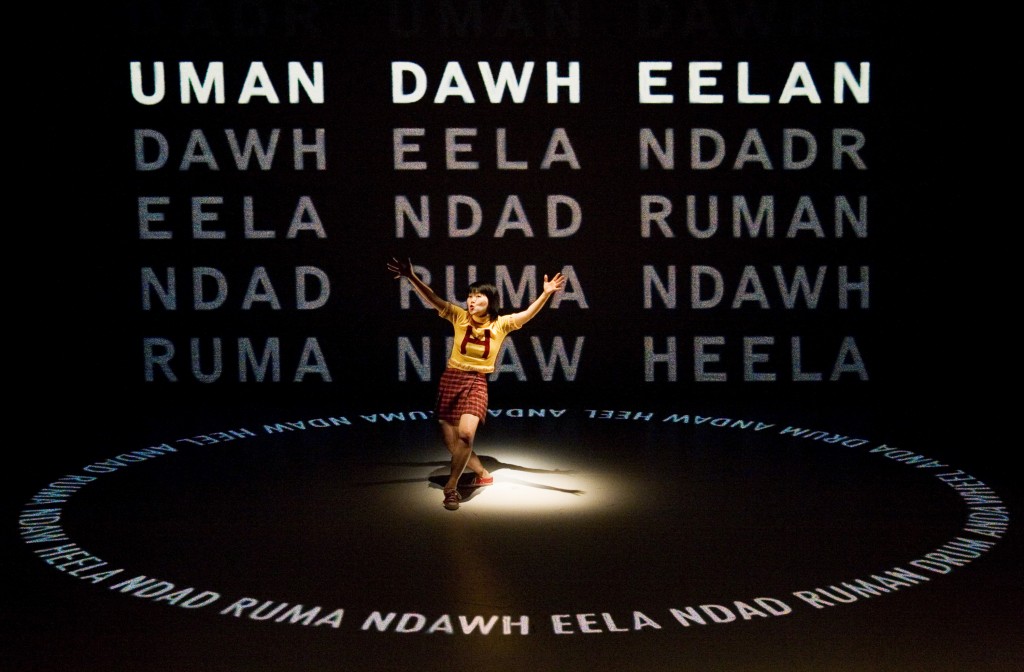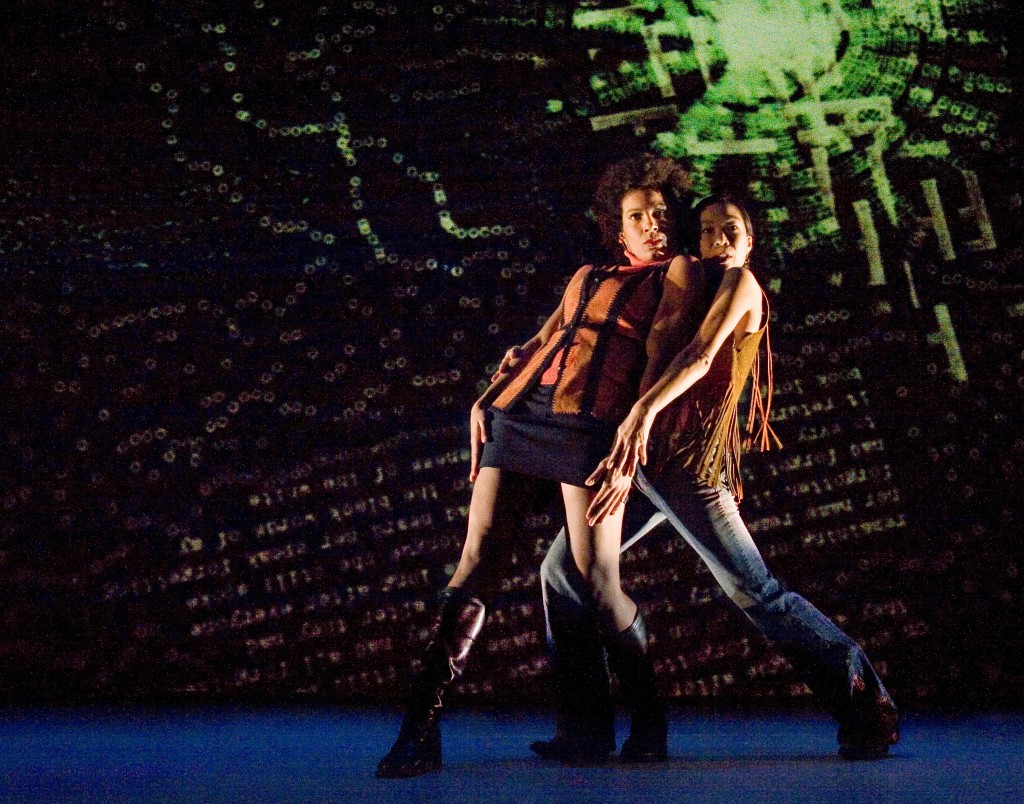
Credit: John Lauener
At The Cultch until November 2, 2014
604-251-1363/tickets.thecultch.com
Posted October 29, 2014
Okay, I confess: the poetry of bpNichol never did it for me and, worse, I’ve never read any of the poetry of Rafael Barreto-Rivera, Paul Dutton or Steve McCaffery who, along with bpNichol, are known amongst the literati as The Four Horsemen, a 1970s, Toronto-based group of poets. Together, they broke down the doors of poetry and according to Sun Media reviewer John Coulbourn (in a 2007 Sun Media review), “ Using often disconnected and even made-up words as a vehicle, they created “sound poetry” to convey emotions at a level deeper than conventional poetry usually cuts.”
Emotions at a deeper level: debatable.
But if you’re going to do sound poetry, let it be the way Volcano Theatre’s The Four Horsemen Project does it: with movement, dance, colour, light, animation, music, a sense of humour and an extraordinary amount of style. As the very professorial academic – who appears as a projection now and again throughout the show – informs us, this show uses “intermedia” which he defines for us as, “a mixture of at least two performance arts.” Two? Let me count the ways!
The genesis of The Four Horsemen Project is almost as interesting as the performance itself. Ross Manson (co-creator/director of this show) heard an old vinyl recording of bpNichol, Dutton, McCaffery and Barreto-Rivera doing “an absolutely avant-garde vocal performance” on – of all programs – Stuart McLean’s Vinyl Café. The recording was no longer available and bpNichol had died during routine back surgery but Dutton was still in Toronto. Manson paired up with co-creator/choreographer Kate Alton to resurrect and revitalize the poetry of The Four Horseman with Dutton’s help and some old tapes.

Credit: John Lauener
The Four Horsemen Project starts with tiny Naoko Murakoshi riffing on three words: DRUM, WHEEL and AND. Dressed like a little cheerleader in a short plaid skirt, red sneakers and a yellow t-shirt with a large, red-emblazoned H on it, Murakoshi is soon backdropped by black and white swirling projected words, “DRUMANDWHEEL” that soon become all the variations: ‘DRU MAN DWHE EL’, ‘DR UMA NDWH EEL’ etcetera.
And so the show proceeds with Andrea Nann, Graham McKelvie and Jennifer Dahl joining Murakoshi as they play with words and sounds, all performed with movement to enhance and embellish words and phrases.
A couple of standouts in The Four Horsemen Project make an interesting point: just as we – possibly those of us of a certain age – are always looking for narrative or for meaning, I struggled to make some sense of it. Perhaps I have lost the delight in playing with sound and words as children do; I simply can’t let go to enjoy the playfulness of it – or, at least, not for long. But the look of the show is fabulous (lighting by Itai Erdal is spectacular) as is the sound (under the musical director of John Millard), Bruce Alcock’s animation and Cass Reimer’s set and costume design. The production is stunning: a whirlwind feast for the eyes and ears.
But the highlights for me are the two most accessible pieces: broad-shouldered, Afro-ed and statuesque Jennifer Dahl takes us through a ‘date’ that ends up with “he/she/cock/cunt/lipslock/hips/ah” and Dahl sprawled, post-coital on the floor then sashaying off with a big smile on her face. The other most accessible piece was danced by Murakoshi and Graham McKelvie in a joyous tribute to Spring and Young Love. Andrea Nann’s solo piece is less narrative but it packs a punch.
Volcano Theatre’s The Four Horsemen Project is undeniably a theatrical experience of very high quality. It seems to take the mickey out of the original four horsemen while simultaneously celebrating them. bpNichol’s Pome Poem, which is repeated several times throughout, makes the point, “What is a pome is inside of your body body body body body what is a pome is inside your head inside your head inside your head inside your head inside your head…” Rap, hip-hop and spoken word all find their origins in poetry like that written by this Canadian group of four.
Over and above the dazzling kaleidoscope of colour, movement and sound, I was reminded how hard-wired I am to find meaning. And I wonder with children and (mostly) young adults always simultaneously bombarded with their iPhones, iPods, tablets, lap-tops and all manner of sensory-overloading electronic gadgetry, whether ‘meaning’ has any meaning for them. Do they have the time and inclination for it? And does it matter? Maybe this old dinosaur should just loosen up.

Credit: John Lauener

